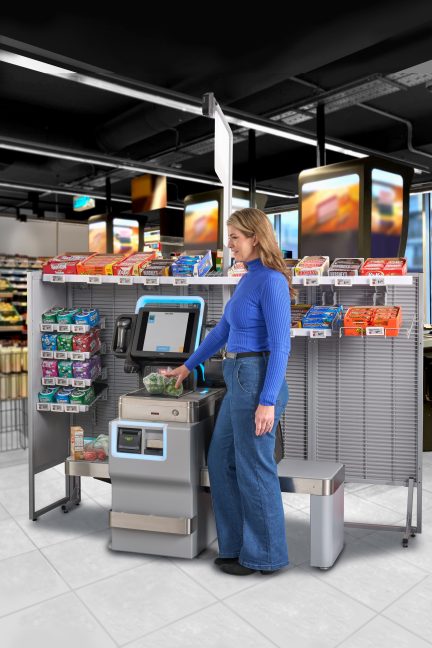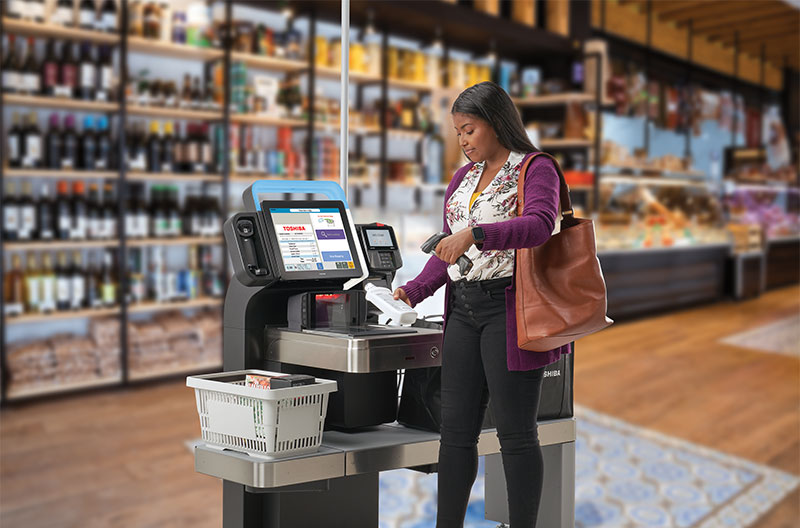For more than two decades, self-checkouts have played an important role in shaping the retail landscape. Initially created as a tool to enable retailers to deploy team members to perform more high-touch tasks in the store, self-checkouts have taken on a much larger role.
As retailers look to create a frictionless POS system and a more positive shopper experience the number of those installing self-checkouts is on the rise. According to Incisiv, some 41 percent of food and grocery retailers offer self-checkout, and an additional 27 percent are in the process of adding it.
Tailoring checkout options and methods of payment to ever-changing customer needs is a must in today’s retail environment, noted Fredrik Carlegren, VP, head of marketing and communications at Toshiba Global Commerce Solutions.
“Consumer needs and expectations are constantly evolving and flexible options at checkout support a more customized and positive shopping experience,” Carlegren said. “Self-checkout solutions also enable speed and frictionless shopping experiences, which are top priorities for shoppers.”
René Stai, head of marketing for LOC Software, said today’s grocery shoppers, many of whom grew up with technology playing a prominent role in their lives, have come to expect these same conveniences where they shop.
“To keep a shopper these days, retailers must adapt to their shopping habits and in this case its technology,” she said.
Added benefits
In our hurry-up-and-go world, no one likes to wait for anything these days. And that fact is evidenced by the change in transaction patterns. Studies show that each year more shoppers are choosing self-checkout lanes to complete their purchases.
This shift can be traced back to the pandemic, noted Carlegren. He pointed out that while initially the increased attraction to self-checkout had much to do with social distancing, since then retailers have also continued to encounter labor shortages, shedding greater light on the technology’s ability to navigate the balance between managing labor and providing excellent consumer shopping experiences.
“When retailers listen to the needs of their shoppers and store associates and deliver the right mix of checkout options, they receive the most significant value,” he said.
Self-checkouts can dramatically reduce the time customers wait in line which translates into a more enjoyable and smooth shopping experience. “We know a growing number of shoppers prefer the self-checkout option,” said Paul Willoughby, VP of POS Solutions, TRUNO Retail Technology Solutions. “Retailers that are hesitant or slow to adopt the technology are losing sales as their shoppers go elsewhere for a more convenient experience.”
Labor savings
Self-checkouts are proving to be an effective tool in addressing labor issues. In this tight market, retailers have found the ability to allocate staff to other areas of the store and reduce the number of cashiers needed results in savings.
“The self-checkout lane empowers retailers to optimize their labor throughout their store which will be reflected in their bottom line,” Willoughby said.
One thing that often concerns independent retailers, he added, is that labor savings comes at the expense of employees’ jobs. “It doesn’t necessarily have to be that way. Labor savings can come through reallocation or repurposing staff into areas that are struggling to fill needs.”

Carlegren pointed out that enhanced self-checkout technology is redefining what it means to work in retail.
“As automated technologies such as self-checkout continue to improve store operations and experiences, retailers are empowered to focus on business priorities like labor distribution, customer service, and offering personalized experiences for shoppers,” he said.
Moreover, when self-checkouts are used correctly, it allows retailers to create new opportunities for store associates to advance their professional skills and be exposed to new development options.
Carlegren pointed out that these new responsibilities and staff reallocations integrate high-tech and interpersonal skills to create dynamic and engaging careers.
“Enhanced retail career opportunities also help drive more personalized and meaningful interactions with shoppers, supporting customer satisfaction and revenue growth,” he said.
Stai at LOC Software said some grocers initially were resistant to adding self-checkout lanes for fear of diminishing the customer experience. But after seeing its value, many have increased the number of self-checkouts.
“We have seen many retailers that may have started with two or three self-checkouts end up adding more because the need is so great,” she said.
Improved shopper experience
The ability to create a more positive in-store experience creates loyalty and increases the chances of shoppers returning to the store.
“Self-checkout systems empower retailers to provide customized checkout experiences for their shoppers, including flexible payments, shopper autonomy, and enhanced security technology, delivering value for retailers,” Carlegren said.
“In some cases, retailers are still assigning store associates to assist shoppers through self-checkout, striking a nice balance between experience, throughput and managing shrink,” he said.
Overcoming challenges
As the technology continues to evolve, many of the initial issues associated with self-checkouts are steadily being addressed – namely, making the units more user friendly and secure. However, it is still a work in progress.
Stai noted that there will always be a hurdle or two to overcome with any new technology. Making sure the customer experience is first and foremost at the center of any design, she added, is key.
“An easy-to-navigate user interface is important as is a screen design that makes sense to shoppers,” Stai said.
For retailers that have never had self-checkouts before, she advised having a clear game plan from the start (or a technology consultant that can help you with best practices). “This will really help the customer base embrace the technology.”
Produce has historically been one of the largest “pain points.” In a recent poll, nearly a quarter of shoppers said they avoid self-checkout lanes when they have produce in their baskets due to the inconvenience and hassle associated with it. Innovative technology in the form of artificial intelligence is poised to change this.
“With the addition of AI, when an apple is placed on the scanner and camera reads it, the system can easily recognize the product and suggest to the shopper how to complete the transaction,” Willoughby said.
Among the benefits, he added, are reducing shrink, increase of throughput and improved customer experience. “Additionally, new AI technology has allowed retailers to turn off the bag scales/weight-based security, allowing for a much-improved customer experience,” he said.
Carlegren agrees that these new technological developments will encourage more consumers to use self-checkouts.
“To meet evolving consumer expectations, retailers realize that having the system recognize and suggest items at checkout is vital to their business. By automatically detecting an item at checkout, produce recognition makes it easier for shoppers to add non-barcoded items, such as fresh fruits and vegetables, to their orders,” Carlegren said.
Technology such as this increases scanning accuracy, making the self-checkout process faster, friendlier, and smarter, he noted.
“Customers can feel more comfortable using self-checkout to scan the contents of their cart, including those non-barcoded produce items,” Carlegren said.
In addition, he said retailers receive the added value of helping eliminate slow transaction times and inaccurate store inventory, reducing loss and giving shoppers an experience that keeps them coming back.
Recent updates to the units have also helped to address the awkwardness of the layout and configuration of the self-checkout area itself. To accommodate customers who prefer to use the self-checkouts but have larger baskets, retailers are able to include a mix of different sized units with small and large bagging areas.
Future of self-checkouts
Over time, self-checkouts are expected to become more intuitive and reliable for retailers and consumers.
“New applications that are already being used including A.I. are redefining the landscape for self-checkouts, produce recognition and customer purchase learning,” Stai said.
Along with making the shopping experience more streamlined, she noted this will aide in the security obstacles that some retailers are facing today.
What’s more, recently introduced enhanced security measures powered by innovative technologies such AI, computer vision and biometrics will positively impact loss prevention efforts in the coming months.
“Newer self-checkout technology has incorporated upgrades – such as cutting-edge video surveillance, produce recognition, weight sensors and A.I. technology – to support loss prevention proactively. These technology innovations help retailers execute loss prevention that align with their stores by alerting store staff or activating security measures when necessary,” Carlegren said.
Continued advancements in produce recognition technology are poised to significantly improve the efficiency and accuracy of self-checkout systems by automatically identifying items and eliminating the need to input codes manually.
“By accurately identifying items through computer vision and A.I. technology, retailers will continue to see improvements in loss prevention and reduce the most common instances of shrink associated with item misidentification,” Carlegren said.
Technology designed to cut down on the amount employees needed to assist with self-checkout issues is also being introduced,
“Minimizing interventions from store associates is a key initiative in reducing friction and shopper frustration at self-checkout,” Carlegren said.
Looking ahead, he expects the customer experience to be improved through enhanced self-checkout security solutions such as new video surveillance and camera technology that can better identify and differentiate between shoppers’ personal items, like a purse or wallet, from products they are purchasing and need to scan.
“For example, when a personal item enters the bagging area, the system determines it is not a retail item, and shoppers can continue their checkout experience without the system pausing and needing an associate to intervene,” he said. “Overall, security-focused technology aims to improve the consumer experience.
“By notifying shoppers of potential errors through proactive alerts, they are empowered to correct the issue themselves – minimizing employee intervention and improving the checkout experience for both the consumer and retailer.”
Read more technology news from The Shelby Report.

